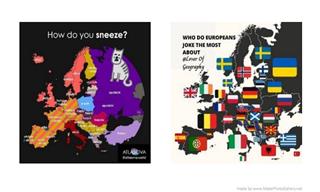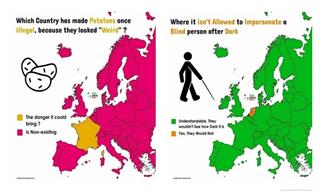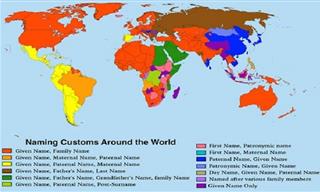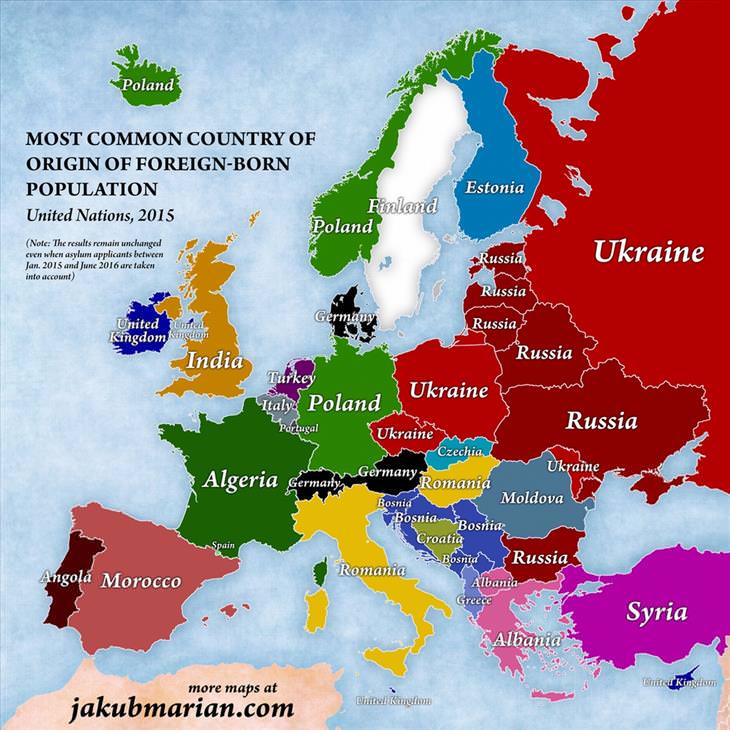
 14:41
14:41
10 Beautiful Places in Austria You Must Visit!
We invite you to join a special journey in the country, looking at 10 different sites that are simply a must.

18 European Maps That Provide Fun and Fascinating Info
These cool and interesting maps will change your perception of Europe.
 6:31
6:31
The Psychology Behind Why Some People Are Habitually Late
Now we finally know why some people are habitually late.

These Maps are the Funniest Way to Understand Europe
These maps show the funny side of Europe!

9 Magical Scottish Towns We'd Love to Visit
If you are planning a trip to Scotland, here are 9 highly recommended towns to exploreץ

Visit an Ancient Map Collection With Thousands of Works!
Visit this great, free collection for an enlightening journey through the annals of cartography.

25 Incredible Facts About the Famous Genghis Khan
Genghis Khan struck fear into the hearts of his subjects during his reign, but there's a lot more to the man than meets the eye. Here are 25 intriguing facts.
 4:04
4:04
This Famous Speech is Still Amazing Today!
One of the greatest speeches ever made, for the love of freedom, the love of human beings.

13 Insightful & Thoughtful Quotes by John F. Kennedy
In this article, we will explore some of the best quotes by John F. Kennedy, which reveal the depth of his wisdom and his dedication to public service.

Looking for a New Hobby? Learn How to Crochet
This playlist will teach you the basic skills you will need to successfully navigate the world of crocheting.

This May Be the Most Amazing Watch Ever Created...
Luxury watch makers Van Cleef & Arpels have created this dazzling creation, showing the planets and our sun while a small comet moves along a track to tell us the time.

A House Locked Away for a Century. What Was Found Inside?
Sealed for a century, this house was just reopened, and with it a window to another place and time.

Baby Boomers, Do You Remember These Vintage Products?
If you are member of the baby boomer generation, you may just remember these nostalgic products from your childhood.

20 Astounding Facts That Will Skew Your Perception of Time
These 20 mind-bending facts will show you just how warped your perception of time really is. Enjoy!

How Many of These Facts About Common Items Do You Know?
Do you know about these facts for common products?

Each Of These 35 Places Represents a Worldly High or Low
When it comes to records, these countries and cities stand at the top (and bottom) of the tree.

These 10 Invaluable World Treasures Were Never Recovered
All 10 of these valuable treasures have a mysterious fate, as they were all stolen or lost not so long ago and never recovered

History: The Full Story of Napoleon's Epic Defeat
The full story of the battles Napoleon fought that eventually lead to his ultimate defeat.

These American History “Facts” Are Actually False
We’ve all believed these American history “facts” at some point.
 13:08
13:08
The Epic Battle of Stalingrad Comes to Life
One of the most epic battles in history, and the biggest of WWII comes to life and explored in this in-depth video.
 2:23
2:23
This Cat Has Broken the Record for the Loudest Purr!
This Cat Has Purred Her Way Into the Record Books!

When Animals Go Rogue: True Tales of Man-Eating Animals
Throughout history, many animals have turned into deadly man-eaters. Here’s a list of the most intense books on the subject.

Send An Affectionate Kiss to Someone You Love Today
To someone you love, a kiss can say a whole lot, and that's why we've put this adorable collection together for you. Share your affection with them today.

18 Unlikely But True Facts That Will Get You Thinking
The saying truth is stranger than fiction is all too true when you read these incredible facts. #2 had me grabbing for my calculator.

7 Conspiracy Stories that Turned Out to be True
These stories are shocking... and they turned out to be true!
 8:37
8:37
The Story of Skidboot: An Amazing Dog!
The story of Skidboot is a happy and sad one...

Where Did These Common Sayings Come From? Fascinating!
You're probably aware of these common sayings, but where did they originate from? Fascinating!

Incredible Maps: The World of Second Languages!
We all know the main languages, but these maps of second languages really surprised me!
 5:11
5:11
Emperor Augustus: How Does History Judge Him?
When speaking of great Roman emperors, perhaps the first that comes to mind is Augustus, who reigned for 41 years and is thought of as the founder of the Roman principle.
 31:27
31:27
Looking Back at the CRAZIEST World Records of 2022
2022’s Guinness World Records will make you wonder if they are for real.

Inside the Male Psyche: The Silent Fears They Never Share
There are some things that a man never shares with anyone.
 9:19
9:19
See How the Egyptians Actually Built the Pyramids
While we marvel at the great pyramids, we know little about how they were actually constructed. This video sheds some light into that.
 11:13
11:13
Is There Anyone Luckier Than These Two Close Friends?
DJ Ginsberg and Marilyn Wagner paid just $2,000 for what would turn out to be a fascinating piece of motion picture history. Hear all about their story here.

These Photos Clearly Indicate You're Never Too Old to Love
You're never too old to love or show love, and these pictures are a clear indication of that. Here are 15 photos that show you never have to stop having fun.
 5:33
5:33
White Rose: the Brave Student Resistance to Nazi Germany
White Rose was a secret student organization that opposed the Nazi rule, here is the story of this brave organization...

14 Nostalgic Pics to Take You Back to the Good Ol’ Days
These photos will instantly trigger your nostalgia.
 50:21
50:21
Can The Mysterious Voynich Manuscript Ever be Cracked?
This is the world's most mysterious book, written by an unknown author in a singular alphabet and illustrated with puzzling images. What is its secret?

15 Lovely Christmas Quotes That Will Fill Your Heart with Joy
These beautiful Christmas are sayings everyone can be thankful for!
 3:48
3:48
This Magical Shadow Dance Show Will Leave You in Tears
The most beautiful shadow dance performance.

5 Unexplained UFO Encounters That Puzzled Experts
We may not believe in UFOs, but throughout history there have been some rather strange UFO-like encounters that defy logic.

The Most Insightful Quotes From the Mind of Albert Einstein
Allow me to share some of the insightful quotes that came out of Albert Einstein's head

20 Maps and Charts That Explain the World in Unique Ways
Time for some more fascinating and informative maps that show interesting aspects of our planet.

Buried by Time: 10 Little-Known Moments in History
These historical events might not be well-known, but they sure are super interesting.

18 of the Most Incredibly-Timed Photos You'll Ever See
These photos will leave you in awe of their timing. The visual impact they have is staggering. Take a look at these 18 images.
 2:13
2:13
The Retirement Home Where Young & Old Live Together
This is a great idea! Young musicians are given free board at a retirement home in exchange for recitals. And this makes for great friendships too!
 15:14
15:14
Ancient Technologies That Remain a Complete Mystery
Scientists may have solved the mystery of Egyptian pyramids, but there are still so many findings that are left completely unexplained






